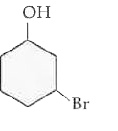Give the structures of A,B and C in the following reactions: CH 3 CH 2 I → NaCN A OH− Partialhydrolysis B → NaOH+Br 2 CSolution in Malayalam
(i) .A. is . ^prime CH_3 CH_2 CN: B. is .CH_3 CH_2 CONH_2 , C. is .CH_3 CH_2 NH_2. (ii) .A=C_6 H_5 CN , B=C_6 H_5 COOH , C=C_6 H_5 CONH_2. (iii) .A=CH_3 CH_2 CN dot B=CH_3 CH_2 CH_2 NH_2: C=CH_3.. .CH_2 CH_2 OH. (iv) .A=C_6 H_3 NH_2 , B=C_6 H_5 ~N_2/ ^+ Cl , C=C_6 H_5 OH. (v) .A=CH_3 CONH_2 , B=CH_3 NH_2 , C=CH_3 OH. (vi) .A=C_6 H_3 NH_2: B=C_6 H_3 ~N_2^+ Cl^-.
Topper's Solved these Questions
Similar Questions
Write the structures of the following compounds (i) α-Methoxypropionaldehyde
View SolutionGlucose or sucrose are soluble in water, but,cyclohexane or benzene (simple six membered ring compounds) are insoluble in water. Explain.
View SolutionExplain the formation of the products in the following reaction.
CH3CH=CHCH2Br+H2O→CH3CH=CHCH2OH+CH3CH(OH)CH=CH2.
View SolutionWhich of the following would you predict to be the stronger acid? (a) Benzoic acid or para-nitrobenzoic acid (b) CH_(3)-CH_(2)-CH_(2)-OH or CH_(3)-CH=CH-OH (c) CH_(3)-CH=CH-CH_(2)-OH or CH_(3)-CH=CH-OH .
View SolutionThe following reaction is a x,y-addition reaction. H_(2)C=CH-CH=CH_(2)+HBr to H_(3)C-CH=CH-CH_(2)Br The value of (x+y) is:
View SolutionConsider the following reactions : (a) ( CH _ 3) _ 3 CCH ( OH ) CH_ 3 overset ( conc. H_ 2 SO _ 4) to (b) ( CH _ 3) _ 2CHCH (Br) CH _ 3 ( alc. KOH) to (c ) ( CH _ 3 ) _ 2 CH CH ( Br ) CH _ 3 ( (CH _ 3) _ 3 ) O^(Theta) K (o+)) to (d) (CH _ 3) _ 2 underset(OH) underset(|) C - CH _ 2 - CHO overset ( Delta ) to Which of these reaction (s) will not produce Saytzeff product ?
View SolutionHow would you carry out the following conversions ? (a) H_(3)C CH_(2)=CH_(2) to H_(3)C- CH_(2)CH_(2)CH_(2)OH (b) H_(3)C CH_(2)-CH =CH_(2) to H_(3)C-CH_(2)-CH(OH)CH_(2)OH (c) H_(3)C C-= CH to H_(3)C COCH_(3) (d) Br_(2)CH CHBr_(2) to HC -=CH
View SolutionName the following compounds according to IUPAC system.
(i) CH3−CH2−CH∣CH2Cl−CH2OH∣CH−CH∣CH3−CH3
(ii) CH3−CH3∣CH−CH2−OH∣CH−CH2OH∣CH−CH3

(iv) H2C=CH−CH∣OH−CH2−CH2−OH
(v) CH2−C∣CH3=C∣Br−CH2OH
View SolutionFor the following compounds, write their bondline formula.
(a) CH3CH(CH3)CH(CH3)CH2CH2OH (b) N≡C−CH∣OH−C≡N
View SolutionConsider the following reactions : (a) ( CH _ 3) _ 3 CCH ( OH ) CH_ 3 overset ( conc. H_ 2 SO _ 4) to (b) ( CH _ 3) _ 2CHCH (Br) CH _ 3 ( alc. KOH) to (c ) ( CH _ 3 ) _ 2 CH CH ( Br ) CH _ 3 ( (CH _ 3) _ 3 ) O^(Theta) K (o+)) to (d) (CH _ 3) _ 2 underset(OH) underset(|) C - CH _ 2 - CHO overset ( Delta ) to Which of these reaction (s) will not produce Saytzeff product ?
View SolutionGive the structures of A, B and C in the following reactions : CH_(3)CH_(2)I overset(NaCN)(rarr) A underset("Partial hydrolysis")overset(OH^(-))(rarr)B overset(NaOH+Br_(2))(rarr)C
View SolutionGive IUPAC name of the following compound.
(i) CH3CH(CI)CH(Br)CH3
CICH2C=CH2Br
View SolutionIdentify 'B' in the following reactions
CH 3 −CH 2 −Br+AgCN → Δ A → C 2 H 5 OH Na B.
View SolutionGive the IUPAC name of the following compounds whose structures are given below :
CH≡C−CH=CH−CH=CH2
View SolutionIn which C–C bond of CH3CH2CH2Br, the inductive effect is expected to be the least?
View Solution
